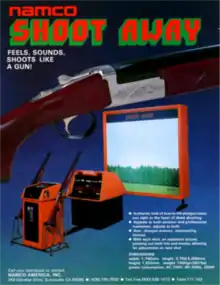Shoot Away
Shoot Away[lower-alpha 1] is a 1977 electro-mechanical arcade game developed and published by Namco. Players use the rifle-shaped light guns to fire at clay pigeons, represented as flying white dots on a projector screen. There are two that must be shot down in each round, and players only get two bullets to hit them. Bonus points are awarded for shooting the pigeons as soon as they appear, or by destroying both of them with a single bullet.
| Shoot Away | |
|---|---|
 | |
| Developer(s) | Namco |
| Publisher(s) | Namco |
| Designer(s) |
|
| Series | Shoot Away |
| Platform(s) | Arcade, Mobile phone |
| Release | |
| Genre(s) | Skeet shooting |
Gameplay
Shoot Away is a lightgun shooter arcade game that simulates the sport of skeet shooting.[1][2] It uses a projector system that projects monochrome images against a panoramic backdrop, designed to resemble a forest clearing.[3] Using the attached lightguns, players have two attempts to shoot at both white targets — representing clay pigeons — that arch across the screen.[4] Both players' scores are shown on an LCD display attached to the gun holsters.[2] There are two difficulty options, "Regular" and "Pro".[5]
Development and release
Development of Shoot Away was done by Sho Osugi, an engineer for Namco that worked on many of the company's driving games for arcades.[6] He was assisted by Kazunori Sawano, best known for his work on Namco's first major hit Galaxian.[7] Shoot Away was one of Namco's first products exported outside Japan, helping establish intercontinental connections with other manufacturers.[8]
Reception and legacy
Shoot Away was Namco's first major arcade hit, and performed considerably well in the United States. Satish Bhutani, the co-founder of Namco America, had difficulty in satisfying the growing demand for the game. Shoot Away remained a popular title in arcades well after its original release, with machines still being sold as late as 1986.[9] Cash Box was enamored with the game's sense of realism, particularly its rifle-shaped lightguns and illuminated projector backdrop. They wrote that it provides "a very appealing atmosphere for the player".[5] Electronic Fun with Computer & Games shared their admiration for its large, vibrant projector screen.[10] In a 1991 retrospective article on electro-mechanical arcade games, CU Amiga writer Julian Rignall ranked Shoot Away as one of the "real interactive games".[11]
In 1978, Namco released a variation of Shoot Away named Clay Champ. It was designed to be smaller and more compact for arcades and other street locations,[3] and used mirror effects combined with projection systems. Allied Leisure released the game in North America in June 1979.[12] In the same year, Allied released a video version titled Clay Shoot. Namco released CosmoSwat in 1984, which was a reskin of Shoot Away that featured a science fiction-motif and a video display on the gun holster stand.
A 1992 sequel, Shoot Away II, was published in Japan, featuring additional difficulties and new fiber optic lightguns.[13] A version that featured rapid-fire lightguns was also produced. Shoot Away II is included as a minigame in Time Crisis II (2001)[14] and Point Blank DS (2006). Namco released a version of Shoot Away for Japanese cellular phones in 2002 through the i-Mode network.[15] A third sequel, Shoot Away Pro, was developed by Bandai Namco Amusement and released in March 2018.[16]
References
- "Shoot Away - Arcade by Namco". Killer List of Videogames. International Arcade Museum. Archived from the original on April 1, 2019. Retrieved September 26, 2020.
- Shoot Away promotional flyer. Namco America. 1984. Archived from the original on September 26, 2020. Retrieved September 26, 2020.
- "Namco's AMOA Exhibit Will Focus On Four Machines" (PDF). Cashbox. November 11, 1978. p. C-16. ISSN 0008-7289.
- "Arcades" (3). United Kingdom. CU Amiga. May 1990. p. 87. Retrieved 18 February 2020.
- "New Equipment" (PDF). Cashbox. February 20, 1982. p. 42. ISSN 0008-7289.
- Wong, Alistar (March 11, 2019). "Chasing Down Memories Of Making Arcade Racers With Namco Veteran Sho Osugi". Siliconera. Curse, Inc. Archived from the original on August 27, 2019. Retrieved October 13, 2019.
- Video Game Museum Project (June 1988). Terebi gēmu (in Japanese). You B You. ISBN 978-4946432316.
- Namco America Opens With Bhutani Heading Up Office (40 ed.). Cash Box. September 23, 1978. pp. 53–55. Retrieved September 8, 2019.
- Johnson, Ethan (November 4, 2017). "Super Sales Six". The History of How We Play. Archived from the original on October 22, 2019. Retrieved September 27, 2020.
- "The Unknown Arcader: Arcades of Boston" (Volume 2, Number 5). Fun & Games Publishing. Electronic Fun with Computer & Games. March 1984. p. 42-49. Retrieved September 27, 2020.
- Rignall, Julian (May 1990). "Arcades" (3). United Kingdom. CU Amiga. p. 87. Retrieved 18 February 2020.
- "Clay Champ - Arcade by Allied Leisure Industries". Killer List of Videogames. International Arcade Museum. Archived from the original on March 25, 2019. Retrieved September 27, 2020.
- Carter, Jay (July 1993). "Insert Coin Here". Decker Publishing. Electronic Games. pp. 16–17. Retrieved September 27, 2020.
- Bramwell, Tom (November 13, 2001). "Time Crisis 2". Eurogamer. Gamer Network. Archived from the original on October 11, 2019. Retrieved September 27, 2020.
- Yokota, Masatoshi (May 1, 2002). "ナムコ、「アプリキャロットナムコ」に「シュータウェイ」を追加". Game Watch (in Japanese). Impress Group. Archived from the original on September 27, 2020. Retrieved September 27, 2020.
- Inamoto, Tetsuya (February 9, 2018). "[JAEPO2018]「SHOOT AWAY PRO」プレイレポート。昔ながらのエレメカを,現代の技術でリニューアルしたクレー射撃ゲームが3月に登場". 4Gamer.net (in Japanese). Aetas. Archived from the original on August 27, 2019. Retrieved September 27, 2020.
